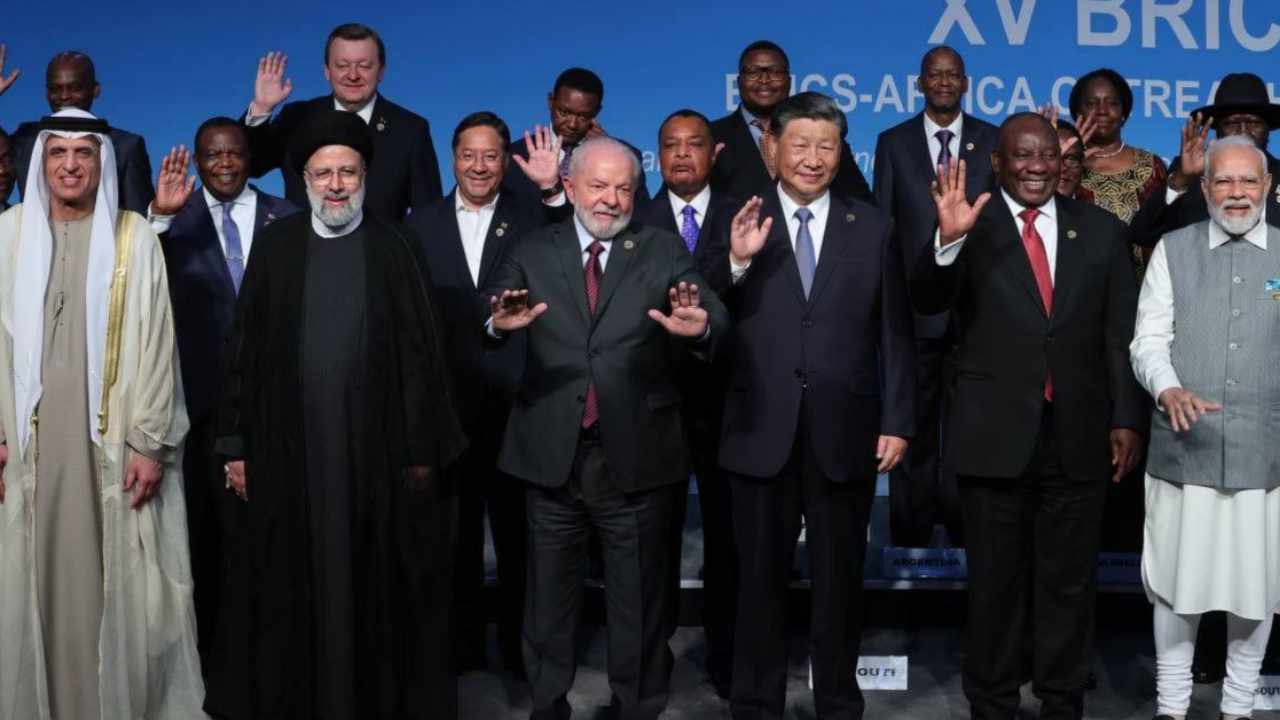
رۆڵی بریکس پلەس لە پەرەپێدانی کۆریدۆرەکانی گواستنەوە و کاریگەرییەکەی لەسەر بازرگانی جیهانی
بریکس پلەس، کە ئێستا ئەندامانی نوێی وەک ئێران، میسر، ئیماراتە یەکگرتووەکانی عەرەبی، عەرەبستانی سعوودی، و ئەتیووپیا لەخۆدەگرێت، وەک یەکێک لە یاریزانە سەرەکییەکان لە لۆجستیک و گواستنەوەی نێودەوڵەتیدا سەرهەڵدەدات. بە کۆنترۆڵکردنی رێگەکانی گواستنەوەی گرنگ وەک کەنالی سوێز و تەنگەی هورموز، و پەرەپێدانی کۆریدۆرە نێودەوڵەتییەکان وەک کۆریدۆری باکوور-باشوور، بریکس پلەس هەڵاڵەکانی بازرگانی جیهانی بە شێوەیەکی نوێ دیاری دەکاتەوە. ئەم وتارە رۆڵی گرووپەکە لە پەرەپێدانی ژێرخانی گواستنەوە، کاریگەرییەکەی لەسەر بازرگانی جیهانی، و ئاستەنگەکانی کە رووبەڕووی دەبێتەوە دەکۆڵێتەوە.

گرنگی کۆریدۆرەکانی گواستنەوە لە بازرگانی جیهانیدا
کۆریدۆرەکانی گواستنەوە، وەک دەستپێشخەری “کەمەربەند و رێگا”ی چین یان کۆریدۆری باکوور-باشوور، وەک رەگە سەرەکییەکانی بازرگانی جیهانی کاردەکەن. ئەم رێگایانە گواستنەوەی کەرگە بە شێوەیەکی کارا و کەم-تێچوو لە نێوان کیشوەرەکاندا ئاسان دەکەن. بریکس پلەس، کە ئەندامانی لە شوێنە جوگرافییە ستراتیژییەکانە، پۆتەنسیاڵی زۆری هەیە بۆ بەهێزکردنی ئەم کۆریدۆرانە. بۆ نموونە، کۆنترۆڵی میسر لەسەر کەنالی سوێز، دەستگەیشتنی ئێران بە کەنداوی پارس و دەریای قەزوین، و بەندەرە گرنگەکانی برازیل لە کەناری ئاتلانتیک، سوودە ستراتیژییەکان بۆ پەرەپێدانی لۆجستیکی جیهانی پێشکەش دەکەن.
رۆڵی ئێران لە کۆریدۆرەکانی گواستنەوە
ئێران، وەک ئەندامێکی نوێی بریکس، رۆڵێکی سەرەکی لە پەرەپێدانی کۆریدۆرەکانی گواستنەوەدا دەگێڕێت. شوێنی جوگرافییەکەی وەک پردێک لە نێوان ئاسیا، ئەوروپا، و رۆژهەڵاتی ناوەڕاست، یەکخستنی رێگەکانی بازرگانی رۆژهەڵات-رۆژئاوا و باکوور-باشوور ئاسان دەکات. کۆریدۆری باکوور-باشوور، کە لە هیندستانەوە بە رێگای ئێرانەوە بۆ رووسیا درێژدەبێتەوە، پرۆژەیەکی سەرەکییە بۆ بریکس پلەس. ئەم کۆریدۆرە دەتوانێت بە شێوەیەکی بەرچاو کات و تێچووی گواستنەوە لە نێوان هیندستان و رووسیا کەم بکاتەوە، کە ئەمەش بازرگانی نێوان ئەم دوو وڵاتە بەرز دەکاتەوە.
هەروەها، پەرەپێدانی بەندەرەکانی ئێران وەک چابهار، دەستگەیشتن بە زەریای هیند پێشکەش دەکات، کە وەک دەرگایەک بۆ کەرگەی هیندستان و چین بۆ گەیشتن بە بازاڕەکانی رۆژهەڵاتی ناوەڕاست و ئەوروپا کاردەکات. ژێرخانی رێگای ئاسنی ئێران کە بەشێکە لە تۆڕی ٣٨٢,٠٠٠ کیلۆمەتری رێگای ئاسنی بریکس، بە شێوەیەکی زیاتر توانای گواستنەوەی گرووپەکە بەرز دەکاتەوە.
هاوکاری لۆجستیکی بریکس پلەس
بریکس پلەس تەرکیزی لەسەر پەرەپێدانی ژێرخانی گواستنەوەیە بۆ بەرزکردنەوەی پێگەی پشبەری جیهانی. بۆ نموونە، پێشنیاری رووسیا بۆ دامەزراندنی بۆرسەی دانەوێڵەی بریکس دەتوانێت نرخی دانەوێڵە سەقامگیر بکات و بازرگانی دانەوێڵەی ناو-گرووپ بەرز بکاتەوە. لە ساڵی ٢٠٢٣دا، وڵاتانی بریکس ١.١٧ ملیار تەن دانەوێڵەیان بەرهەمهێنا، کە ٤٢٪ی بەرهەمهێنانی جیهانی پێکدەهێنا. بە زیادبوونی ئەندامانی نوێ، ئەم ژمارەیە بۆ ١.٢٤ ملیار تەن بەرز بووە.
هەروەها، بریکس پلەس کاردەکات بۆ دروستکردنی تۆڕێک لە رێگەکانی گواستنەوە کە سەربەخۆیە لە رێگەکانی ژێر کۆنترۆڵی رۆژئاوا. ئەمە بەتایبەتی گرنگە بەهۆی سزاکانی رۆژئاوا کە رێگەکانی بازرگانی کۆنیان تێکداوە. بۆ نموونە، سزاکانی نەوت لەسەر رووسیا و ئێران، ئەم دوو وڵاتەیان ناچار کردووە کۆریدۆرەکانی گواستنەوەی جێگرەوە پەرەپێبدەن.
ئاستەنگەکانی لۆجستیکی
سەرەڕای پۆتەنسیاڵەکەی، بریکس پلەس تووشی ئاستەنگەکانی لۆجستیکی دەبێت. هەندێک لە وڵاتانی ئەندام، وەک ئەتیووپیا، سەرەڕای شوێنی ستراتیژییان لە قەرنی ئەفریقا، کەمی ژێرخانی بەندەرییان هەیە. هەروەها، کێشە سیاسی و ئابوورییەکان، بەتایبەتی لە نێوان چین و هیندستان، دەتوانن هاوکاری لۆجستیکی ئاستەنگ بکەن. پەستانە دەرەکییەکان، وەک هەڕەشەکانی باجی ئەمریکی لە ساڵی ٢٠٢٥دا، دەشتوانن سەرمایەگوزاری لە پرۆژەکانی گواستنەوە لەلایەن هەندێک ئەندامەوە کەم بکەنەوە.
کاریگەری لەسەر بازرگانی جیهانی
پەرەپێدانی کۆریدۆرەکانی گواستنەوە لەلایەن بریکس پلەسەوە دەتوانێت دینامیکەکانی بازرگانی جیهانی بگۆڕێت. بە کەمکردنەوەی پشتبەستن بە رێگەکانی ژێر کۆنترۆڵی رۆژئاوا وەک کەنالی پاناما یان تەنگەی مەلاکا، بریکس پلەس دەتوانێت هەڵاڵەکانی بازرگانی بەرەو رێگەکانی جێگرەوە رەوانە بکات. ئەمە نەک تەنها بازرگانی ناو-گرووپە بەرز دەکاتەوە، بەڵکو وڵاتانی پەرەپێدەر توانای زیاتریش دەدات بۆ بەشداریکردنی چالاکانە لە بازرگانی جیهانیدا.
هەروەها، پەرەپێدانی کۆریدۆرەکانی گواستنەوە دەتوانێت سەرمایەگوزاری بیانی سەرنجراکێش بکات. بۆ نموونە، سەرمایەگوزارییەکانی چین لە بەندەری چابهار لە ئێران و پرۆژەکانی کەنالی سوێز لە میسر دەتوانن تواناکانی بازرگانی ئەم وڵاتانە بەرز بکەنەوە. ئەم سەرمایەگوزارییانە هەروەها هەلی کار دروست دەکەن و ئابووری ناوخۆیی بەهێز دەکەن.
ئەنجام
بریکس پلەس خۆی وەک سەرکردەیەک لە بازرگانی جیهانیدا جێگیر دەکات بە تەرکیزکردن لەسەر کۆریدۆرەکانی گواستنەوە و ژێرخانی لۆجستیکی. رۆڵی ئێران، میسر، و ئەندامانی دیکەی نوێ لەم پرۆسەیەدا گرنگە، بەڵام سەرکەوتن بەستراوە بە سەرەکەوتن لە سەر ئاستەنگەکانی ناوخۆیی و دەرەکی. بە بەردەوامبوون لەم رێگایەدا، بریکس پلەس دەتوانێت وەک جێگرەوەیەکی بەهێز بۆ سیستەمی بازرگانی ژێر سەرەوەری رۆژئاوا سەرهەڵبدات.
سەرچاوە: ئیغتساد مواسر – بەهێزکردنی بەرژەوەندی و مافەکانی ئابوورییە پەرەپێدەرەکان
